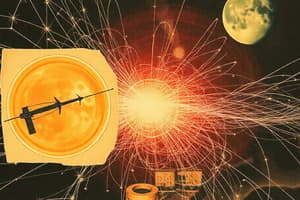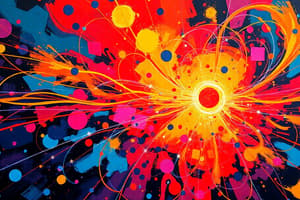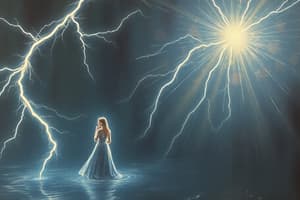Podcast
Questions and Answers
A proton is moving with velocity $\vec{v}$ in a magnetic field $\vec{B}$. Which of the following changes would maximize the magnetic force on the proton?
A proton is moving with velocity $\vec{v}$ in a magnetic field $\vec{B}$. Which of the following changes would maximize the magnetic force on the proton?
- Orienting $\vec{v}$ parallel to $\vec{B}$ and reducing the charge of the proton.
- Decreasing the angle between $\vec{v}$ and $\vec{B}$ to 0 degrees.
- Decreasing the velocity of the proton to zero.
- Increasing the magnitude of the magnetic field $\vec{B}$ and making $\vec{v}$ perpendicular to $\vec{B}$. (correct)
Which of the following statements accurately describes the behavior of magnetic field lines?
Which of the following statements accurately describes the behavior of magnetic field lines?
- They always point in the direction of decreasing electric potential.
- They originate from positive charges and terminate at negative charges.
- They form closed loops, originating from the north pole and terminating at the south pole of a magnet. (correct)
- They are parallel to the direction of an electric field.
A wire carries a steady current. According to Ampère-Maxwell's Law, what generates the magnetic field around the wire?
A wire carries a steady current. According to Ampère-Maxwell's Law, what generates the magnetic field around the wire?
- Both the electric current and any changing electric field.
- Only the electric current flowing through the wire. (correct)
- Only the displacement current due to changing electric fields.
- Neither electric current nor changing electric fields, but rather the resistance of the wire.
How does increasing the number of turns in a coil affect its inductance, assuming all other parameters remain constant?
How does increasing the number of turns in a coil affect its inductance, assuming all other parameters remain constant?
In an electromagnetic wave propagating through a vacuum, what is the relationship between the electric field (E) and the magnetic field (B)?
In an electromagnetic wave propagating through a vacuum, what is the relationship between the electric field (E) and the magnetic field (B)?
A parallel plate capacitor is charged and then disconnected from the power supply. What happens to the electric field between the plates if the distance between the plates is doubled?
A parallel plate capacitor is charged and then disconnected from the power supply. What happens to the electric field between the plates if the distance between the plates is doubled?
Which of Maxwell's equations implies the non-existence of magnetic monopoles?
Which of Maxwell's equations implies the non-existence of magnetic monopoles?
A ferromagnetic material is placed inside a solenoid. How does this affect the magnetic field inside the solenoid?
A ferromagnetic material is placed inside a solenoid. How does this affect the magnetic field inside the solenoid?
According to Lenz's Law, what determines the direction of the induced current in a circuit?
According to Lenz's Law, what determines the direction of the induced current in a circuit?
In a series RC circuit connected to an AC voltage source, what is the phase relationship between the voltage across the resistor and the voltage across the capacitor?
In a series RC circuit connected to an AC voltage source, what is the phase relationship between the voltage across the resistor and the voltage across the capacitor?
Flashcards
Electromagnetism
Electromagnetism
A fundamental force of nature encompassing electric and magnetic phenomena.
Electric Charge
Electric Charge
A fundamental property of matter that can be positive or negative.
Electric Current
Electric Current
The flow of electric charge.
Electric Field
Electric Field
Signup and view all the flashcards
Coulomb's Law
Coulomb's Law
Signup and view all the flashcards
Magnetic Fields
Magnetic Fields
Signup and view all the flashcards
Ferromagnetic Materials
Ferromagnetic Materials
Signup and view all the flashcards
Electromagnetic Induction
Electromagnetic Induction
Signup and view all the flashcards
Faraday's Law
Faraday's Law
Signup and view all the flashcards
Electromagnetic Waves
Electromagnetic Waves
Signup and view all the flashcards
Study Notes
- Electromagnetism is one of the four fundamental forces of nature.
Fundamental Concepts
- Electromagnetism encompasses both electric and magnetic phenomena, which are inseparable and related to moving electric charges.
- Electric charge is a fundamental property of matter that can be positive or negative.
- Like charges repel, and opposite charges attract.
- Electric current is the flow of electric charge.
- Magnetic fields are created by moving electric charges or electric currents.
- Electromagnetic force is mediated by photons, which are massless particles.
Electric Fields
- Electric field is a vector field that exists in the space around electric charges, exerting a force on other charges within the field.
- Electric field lines are used to visualize electric fields, showing the direction of the force on a positive test charge.
- Electric potential is the electric potential energy per unit charge at a specific location in an electric field, measured in volts (V).
Coulomb's Law
- Coulomb's Law quantifies the force between two point charges: ( F = k \cdot \frac{|q_1 \cdot q_2|}{r^2} ), where:
- ( F ) is the electrostatic force.
- ( k ) is Coulomb's constant (( \approx 8.987 \times 10^9 , \text{N m}^2/\text{C}^2 )).
- ( q_1 ) and ( q_2 ) are the magnitudes of the charges.
- ( r ) is the distance between the charges.
- This force is attractive if the charges are of opposite signs and repulsive if the charges are of the same sign.
Magnetism
- Magnetic fields are created by moving electric charges and exert a force on other moving charges.
- Magnetic field lines form closed loops, originating from the north pole and terminating at the south pole of a magnet.
- Magnetic flux is a measure of the quantity of magnetism, being the number of magnetic field lines passing through a surface.
- Magnetic force on a moving charge is given by ( \vec{F} = q(\vec{v} \times \vec{B}) ), where:
- ( \vec{F} ) is the magnetic force.
- ( q ) is the charge.
- ( \vec{v} ) is the velocity of the charge.
- ( \vec{B} ) is the magnetic field.
Magnetic Materials
- Ferromagnetic materials (e.g., iron, nickel, cobalt) exhibit strong magnetic properties and can be easily magnetized.
- Paramagnetic materials are weakly attracted to magnetic fields.
- Diamagnetic materials are weakly repelled by magnetic fields.
Electromagnetism
- Electromagnetism describes the interaction between electric and magnetic fields.
- Maxwell's equations unify electric and magnetic phenomena.
- Electromagnetic induction occurs when a changing magnetic field induces an electromotive force (EMF) in a conductor.
- Faraday's Law of Induction: The induced EMF in any closed circuit is equal to the negative of the time rate of change of the magnetic flux through the circuit (( \mathcal{E} = -\frac{d\Phi_B}{dt} )).
- Lenz's Law: The direction of the induced current is such that it opposes the change in magnetic flux that produces it.
Maxwell's Equations
- Maxwell's equations describe the behavior of electric and magnetic fields, and how they relate to each other as well as to electric charges and currents.
- Gauss's Law for Electricity: Relates the electric field to the distribution of electric charges (( \nabla \cdot \mathbf{E} = \frac{\rho}{\varepsilon_0} )).
- Gauss's Law for Magnetism: States that magnetic monopoles do not exist, meaning magnetic field lines always form closed loops (( \nabla \cdot \mathbf{B} = 0 )).
- Faraday's Law of Induction: Describes how a changing magnetic field creates an electric field (( \nabla \times \mathbf{E} = -\frac{\partial \mathbf{B}}{\partial t} )).
- Ampère-Maxwell Law: Describes how a magnetic field is generated by an electric current and/or by a changing electric field (( \nabla \times \mathbf{B} = \mu_0\left(\mathbf{J} + \varepsilon_0 \frac{\partial \mathbf{E}}{\partial t}\right) )).
Electromagnetic Waves
- Electromagnetic waves are disturbances in electric and magnetic fields that propagate through space.
- These waves are transverse waves, where the electric and magnetic fields are perpendicular to each other and to the direction of propagation.
- Electromagnetic waves travel at the speed of light (( c \approx 3.0 \times 10^8 , \text{m/s} ) in a vacuum).
- The electromagnetic spectrum includes radio waves, microwaves, infrared, visible light, ultraviolet, X-rays, and gamma rays, differing in frequency and wavelength.
Inductance
- Inductance (L) is the property of a circuit element to oppose changes in current due to the generation of a back EMF.
- The inductance of a coil depends on its geometry (number of turns, area, length) and the permeability of the core material.
- Inductors store energy in a magnetic field.
Capacitance
- Capacitance (C) is the ability of a component or circuit to collect and store energy in the form of an electrical charge.
- Capacitance is measured in farads (F).
- Capacitors store energy in an electric field.
Electric Circuits
- An electric circuit is a closed path through which electric current flows.
- Ohm's Law relates voltage (V), current (I), and resistance (R): ( V = IR ).
- Resistors impede the flow of current and dissipate energy as heat.
- Series circuits: Components are connected end-to-end, so the current is the same through each component.
- Parallel circuits: Components are connected side-by-side, so the voltage is the same across each component.
Studying That Suits You
Use AI to generate personalized quizzes and flashcards to suit your learning preferences.




